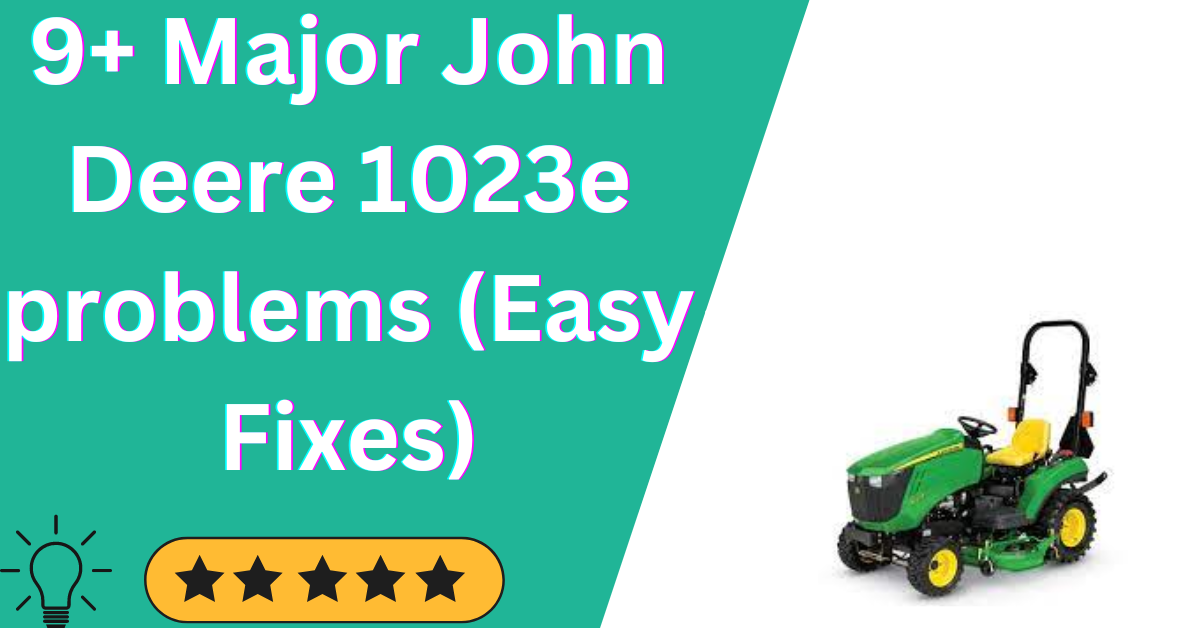John Deere 1023E utility tractor was introduced in 2012 as an economy-minded model aimed at homeowners and hobby farms. Overall, it has proven to be a capable and reliable machine. However, as with any tractor, there are some common John Deere 1023e problems that owners should be aware of. Being able to quickly diagnose and fix minor issues can prevent downtime and expensive repairs.
9 common John Deere 1023e problems with Solutions
Now we are going to discuss the 9 most common problems of John Deere 1023e along with their easy solutions.
1. Transmission Issues:
Some users have reported concerns related to the transmission system. This may manifest as difficulties in shifting gears or an inconsistent power delivery.
Causes:
- Transmission Fluid Issues: Low or contaminated transmission fluid can lead to difficulties in gear shifting and cause inconsistent power delivery.
- Clutch Adjustment or Wear: A poorly adjusted or worn-out clutch can result in challenges when shifting gears and may contribute to power delivery issues.
- Hydraulic System Problems: Issues in the hydraulic system, such as low hydraulic fluid levels or malfunctioning components, can affect the operation of the transmission.
Solutions:
- Make sure the transmission fluid levels are within the recommended range on a regular basis.
- Replace the transmission fluid at the specified intervals using the manufacturer-recommended type.
- Inspect the clutch for wear and adjust it according to the manufacturer’s guidelines.
- Replace the clutch if it shows signs of significant wear or damage.
- Regularly check hydraulic fluid levels and address any leaks promptly.
- Inspect hydraulic components and filters for proper functioning and replace as necessary.
- By following these steps you can easily get rid of John Deere 1023e transmission problems.
2. Hydraulic System Challenges:
The hydraulic system is critical for various functions of the tractor, including loader and implement operations. Users have occasionally encountered problems such as slow hydraulic response or hydraulic leaks. Regular inspection, maintenance, and addressing leaks promptly are essential to keep the hydraulic system functioning optimally.
Solutions:
Conduct regular inspections of the hydraulic system for leaks or slow response. Address any leaks promptly and maintain the hydraulic fluid at the recommended levels. Seek professional assistance if issues persist.
Also read this How to check hydraulic fluid level on John Deere tractor
3. Starting Problems
A few users have reported difficulties in starting the John Deere 1023E. This could be attributed to issues with the battery, starter, or fuel system. Routine checks on the battery’s charge, the starter’s functionality, and ensuring a clean fuel system can help prevent John Deere 1023e starting problems.
Solutions:
- Check the battery regularly for charge and condition.
- Ensure the starter is functioning correctly.
- Keep the fuel system clean, and use quality fuel.
- If starting issues persist, consult with a technician to inspect and address any potential problems.
4. Engine Performance Issues:
Users have mentioned occasional concerns regarding engine performance, including issues with power delivery and fuel efficiency. Regular servicing of the engine, checking the air filter, and ensuring proper fuel quality can contribute to improved engine performance.
Solutions:
Follow the Manufacturer’s Recommended Service Intervals:
The manufacturer provides a comprehensive schedule for routine maintenance tasks, including those specific to the engine. This schedule typically outlines intervals for oil changes, filter replacements, and overall engine inspections. Adhering to these intervals is crucial for keeping the engine in peak condition.
Regularly Inspect the Air Filter:
The air filter prevents dust and debris from entering the engine. Regular inspections of the air filter are essential to ensure it is clean and functioning effectively. If the air filter is clogged or dirty, it can restrict airflow to the engine, leading to decreased performance and efficiency.
Procedure for Air Filter Inspection:
- Locate the air filter housing.
- Remove the air filter cover.
- Inspect the filter for dirt, dust, or damage.
- If the filter is dirty, clean it if it’s reusable or replace it with a new one if necessary.
Replace the Air Filter if Necessary:
If the air filter is found to be dirty or damaged during inspection, it should be replaced promptly. Using a damaged or clogged air filter can lead to increased fuel consumption, reduced engine power, and potentially more severe engine issues over time.
Procedure for Air Filter Replacement:
- Purchase a compatible replacement air filter.
- Remove the old air filter.
- Install the new air filter, ensuring it is correctly positioned and secured.
- Replace the air filter cover.
Use High-Quality Fuel:
The quality of fuel directly impacts engine performance and longevity. It is recommended to use high-quality, clean fuel with the appropriate octane rating as specified by the manufacturer. Quality fuel helps prevent fuel system deposits, combustion issues, and other engine-related problems.
You may also read this How Often to Change John Deere Oil?
Tips for Using High-Quality Fuel:
- Purchase fuel from reputable and reliable sources.
- Avoid using stale or contaminated fuel.
- Store fuel in clean and sealed containers to prevent impurities.
5. Electrical System Challenges:
Electrical issues, such as problems with lights, gauges, or the ignition system, have been reported by some users. It is a very common John Deere 1023e problem that its owners face. Because if your lawn mower refuses to start then it might be some electrical issues behind them like dead battery or wiring issues.
There are some causes behind electrical problems are:
- Faulty battery
- Loose or damaged wiring
- Blown fuses
- Malfunctioning alternator
Solutions
- Load test battery — replace if necessary
- Check all wiring — repair loose connections, replace damaged wires
- Check and replace blown fuses
- Test alternator output — repair/replace alternator as needed
6. PTO (Power Take-Off) Problems
As the PTO is crucial for powering implements, any issues with its engagement or disengagement can impact the tractor’s functionality. Regular lubrication, checking for debris, and ensuring proper adjustments can address potential PTO problems.
Solutions:
Ensure regular lubrication of the PTO components and check for any debris that may affect engagement. Adjust the PTO as per the manufacturer’s guidelines. If problems persist, seek professional assistance for a detailed examination.
7. Steering Difficulties
Steering-related problems, such as excessive play or difficulties in turning, have been mentioned. There are some causes behind the John Deere 1023E steering problems are.
Causes:
- Low power steering fluid
- Damaged steering cylinder hoses
- Faulty steering control valve
- Loose steering linkage
Solutions:
Regularly Inspect Steering Components:
Steering components, including the gearbox, linkages, and tie rods, are critical for maintaining precise control of the tractor. Regular inspections should be carried out to identify any signs of wear, damage, or loose connections.
Procedure for Steering Component Inspection:
- Lift the tractor’s front wheels off the ground for better access.
- Visually inspect the gearbox, linkages, and tie rods for signs of rust, wear, or damage.
- Check for any loose connections or play in the steering components.
- Rotate the steering wheel to its full extent to ensure smooth operation.
Adjust steering as per Manufacturer’s Recommendations:
The manufacturer provides specific guidelines for steering adjustments. These adjustments may include settings for steering wheel play, wheel alignment, and overall responsiveness. Adhering to these recommendations helps maintain optimal steering performance.
Typical Steering Adjustments:
- Steering Wheel Play: Adjusting the steering wheel to minimize excess play ensures a more responsive and precise steering feel.
- Wheel Alignment: Proper wheel alignment prevents uneven tire wear and enhances overall stability.
Procedure for Steering Adjustments:
- Refer to the tractor’s operator manual for the manufacturer’s recommended steering adjustments.
- Use the appropriate tools to make necessary adjustments based on the provided specifications.
- Perform a test drive to assess the steering responsiveness.
Seek Professional Assistance if Steering Issues Continue:
If steering issues persist despite regular inspections and adjustments, it is advisable to seek professional assistance from authorized John Deere service providers or qualified technicians. Persistent steering problems could indicate underlying issues that require expert diagnosis and resolution.
Reasons to Seek Professional Assistance:
- Unusual noises during steering operation.
- Excessive play or stiffness in the steering wheel.
- Uneven tire wear despite proper alignment adjustments.
- Professional technicians have the expertise and tools to conduct in-depth diagnostics and repairs, ensuring the steering system operates at its best.
8. Seat Comfort Issues
While not directly impacting the tractor’s performance, some users have expressed dissatisfaction with the comfort of the tractor seat. This is a subjective concern, and individual preferences may vary. Adding cushions or exploring after market seat options can enhance operator comfort.
Solutions:
Explore aftermarket seat options, or consider adding cushions for improved comfort. Ensure the seat is properly adjusted to the operator’s preferences. If discomfort persists, consult with the manufacturer or authorized dealers for alternative seat options.
9. Loss of Power Under Load
This problem occurs with most of the owners. Their tractor suddenly loss the power under load. This happens due to several reasons.
Causes:
- Clogged Air Filter: A clogged air filter restricts the airflow into the engine, leading to reduced combustion efficiency and, consequently, loss of power under load.
- Fouled Fuel Injectors: Fuel injectors play a crucial role in delivering the right amount of fuel to the engine. When fouled or clogged, fuel delivery is disrupted, resulting in power loss.
- Low Engine Compression: Low compression levels in the engine cylinders can lead to decreased power output, especially under load.
- Hydraulic Restriction: Hydraulic systems are crucial for various tractor functions. If there’s a restriction, it can affect the tractor’s ability to perform under load, particularly with hydraulic-powered implements.
Solutions:
Replace Air Filter:
- Locate the air filter housing and remove the cover.
- If the air filter is visibly dirty or clogged, replace it with a new, clean filter.
- Regularly replace the air filter as part of routine maintenance.
Clean or Replace Fuel Injectors:
- Consult a professional technician for a thorough inspection of the fuel injectors.
- Cleaning or replacing fuel injectors may be necessary based on diagnostic findings.
- Regularly use high-quality fuel to prevent injector fouling.
Test Engine Compression: Repair as Needed:
- Conduct a compression test using a compression gauge.
- If compression levels are low, consult with a professional for a detailed engine inspection.
- Repair or replace components contributing to low compression.
Check Hydraulic Filters — Replace as Needed:
- Regularly inspect hydraulic filters for signs of blockage or damage.
- Replace hydraulic filters as recommended by the manufacturer or if blockage is detected.
- Ensure proper hydraulic fluid levels and address any leaks promptly.
Conclusion:
Now You have got the complete details about the John Deere 1023e problems because here I provide the complete details about it. Now, whenever your tractor any of these problems, you can solve them easily.
Diagnosing issues quickly is key to minimizing downtime with the 1023E. Following routine maintenance procedures and inspecting components regularly can help avoid many common problems.








